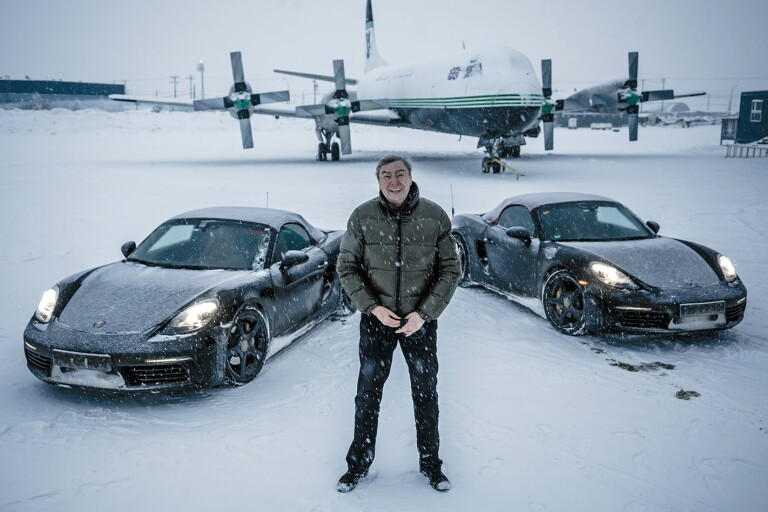
It’s the second week of December in Yellowknife, a thriving northern Canadian town within frozen spit-tossing distance of the Arctic Circle.
We’ve travelled here to meet the new Porsche 718, which comes to market in April as a Boxster and six months later as a Cayman. The 718 moniker is inspired by the mid-engine lightweight street-legal racer built and campaigned from 1957 to ’64.
Way more significant is the fact the Boxster engine room now houses a turbocharged flat-four, rather than the legendary flat-six which has served since time immemorial. For 2016, Boxster swaps two cylinders for a single snail.

“We were facing a complex task,” project leader Jan Roth tells MOTOR. “Marketing wanted to move the mid-engined cars further away from the 911. The result is a new four-cylinder boxer.
“Why not a smaller-displacement flat-six? Because now we’re introducing turbocharging across the board, it would have been impossible to package the bigger powerplant. Believe me, it was difficult enough to find space for the flat-four with the related extra intake and exhaust plumbing, not to mention the intercooler assembly. For these reasons alone, a turbo-six was never on our radar.”
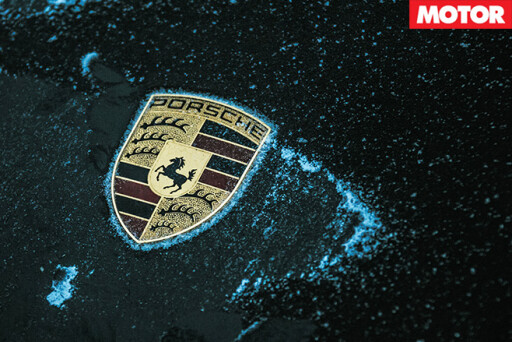 During Porsche’s history, only five historical models have come with four-pot engines: the 718, 904, 356, 912 and 914 series all used versions of the Beetle-inspired, air-cooled, carb-fed flat-four. In contrast, the new engine, codenamed EA9A2, is an all-new and high-tech direct-injection variable-vane turbo 16-valver.
During Porsche’s history, only five historical models have come with four-pot engines: the 718, 904, 356, 912 and 914 series all used versions of the Beetle-inspired, air-cooled, carb-fed flat-four. In contrast, the new engine, codenamed EA9A2, is an all-new and high-tech direct-injection variable-vane turbo 16-valver.
Initially, there will be two engines, a 225kW/360Nm 2.0-litre and a 255kW/400Nm 2.5-litre. Mid-term, a brawnier GTS, good for at least 275kW, will complete the range. And yes, there is still enough room for a normally aspirated six...
“Downsizing offers various advantages,” says Matthias Hofstetter, engineer and Sports Car Drivetrain Development boss. “For a start, the turbocharged four-cylinder produces up to 100Nm more torque than the outgoing six. At the same time, it is instrumental in reducing the average fuel consumption by 15 per cent.”
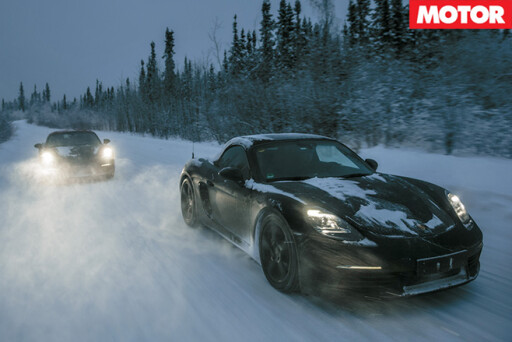 Backing up the impressive claims are impressive numbers. While the Boxster S can accelerate 0-100km/h in 4.9sec and top 280km/h, the base model is only half a second slower off the mark and a mere 10km/h short in maximum speed.
Backing up the impressive claims are impressive numbers. While the Boxster S can accelerate 0-100km/h in 4.9sec and top 280km/h, the base model is only half a second slower off the mark and a mere 10km/h short in maximum speed.
The 2.0-litre engine feels more agile and spontaneous, the bigger unit not obeying the throttle quite as promptly, but in the wake of that initial turbo-lag, mumbo builds more rapidly and climbs to a taller peak.
“Today, normally-aspirated and turbocharged engines still live side by side,” Hofstetter adds. “In the future however, the turbo is going to pull away big-time. It doesn’t only radically re-plot the torque curve, it’s also an essential CO2-reducing tool.”
 Pushing the Sport Response Button in the rotary control on the steering-wheel kicks all systems into Sport Plus mode for up to 20 seconds. The PDK transmission upshifts later, at higher revs. It’s no revolution, but is a nice new feature. There are four settings: Zero for comfort; Sport alerts all six senses; Sport Plus is a hyper-alert track-only program; and Individual invites the selection of personal favourites.
Pushing the Sport Response Button in the rotary control on the steering-wheel kicks all systems into Sport Plus mode for up to 20 seconds. The PDK transmission upshifts later, at higher revs. It’s no revolution, but is a nice new feature. There are four settings: Zero for comfort; Sport alerts all six senses; Sport Plus is a hyper-alert track-only program; and Individual invites the selection of personal favourites.
Unlike many rivals, Porsche refuses to include steering action in the drive-mode Scrabble, although braking response soon will be. The internal 981 designation suggests the 718 is more than a mere facelift, but even hardcore brand fetishists will need to look twice to spot the changes. Inside, Porsche developed a new instrument panel to lose the noisy, breathless old air vents, though such luxurious perfection may soon be history.
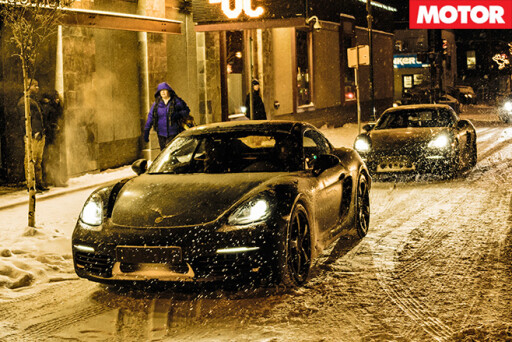 All exterior sheetmetal and composite parts bar the rear bootlid are re-done. The only eye-catching novelties are restyled LED head- and tail-lights: four bright dots per unit, plus a set of horizontal light bars operating indicators and rear lamps.
All exterior sheetmetal and composite parts bar the rear bootlid are re-done. The only eye-catching novelties are restyled LED head- and tail-lights: four bright dots per unit, plus a set of horizontal light bars operating indicators and rear lamps.
More advanced options like a fully adaptive matrix beam system, long-overdue head-up display and intuitive ergonomics must wait until 2020 when project 983 takes over. By 2021 at the latest, battery-operated versions of both models are expected.
Even though exceptional vehicle dynamics have always been a forte of these two mid-engined crackerjacks, the Weissach think-tank pulled various strings “to get even closer to 10 out of 10”.
 This includes the electrically-assisted power steering. With only 2.5 turns lock-to-lock, it’s now 10 per cent quicker, yet more stable around the straight-ahead position. The upcoming baseline Boxster receives bigger brakes than the outgoing S model, the new S decelerating with assemblies borrowed from the 911.
This includes the electrically-assisted power steering. With only 2.5 turns lock-to-lock, it’s now 10 per cent quicker, yet more stable around the straight-ahead position. The upcoming baseline Boxster receives bigger brakes than the outgoing S model, the new S decelerating with assemblies borrowed from the 911.
Even though the basic suspension settings are a convincing compromise, the adaptive PASM dampers are better still at soaking up potholes and neutralising expansion joints. Not quite firm and precise enough? Then hit the Sport button and dial in a tauter setting, which ties the car down nicely without sending shockwaves through you or the partial aluminium chassis structure.
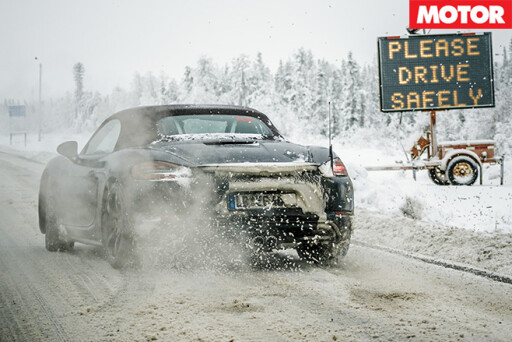 “More than anything else we aimed at improving the overall driveability,” says Joachim Meyer, Senior Chassis Engineer of the sports car division. “At the end of the day, it’s often the little things which add up to a tangible step forward. I’m thinking of minor changes like half an inch wider rear wheels, mildly tweaked suspension kinematics and more sensitive ABS, ASR and PSM software.”
“More than anything else we aimed at improving the overall driveability,” says Joachim Meyer, Senior Chassis Engineer of the sports car division. “At the end of the day, it’s often the little things which add up to a tangible step forward. I’m thinking of minor changes like half an inch wider rear wheels, mildly tweaked suspension kinematics and more sensitive ABS, ASR and PSM software.”
Manual or PDK transmission? The progressive clutch, eager throttle and slick gearshift match the driver’s feet and shift arm with aplomb – but in Canadian winter conditions, the dual-clutch PDK ’box is preferred. Keeping both hands on the wheel, snappy flappy-paddle gear changes don’t dent the flow nearly as much as two-second manual upshifts.
 Some Porsche R&D boffins have been returning to these frozen badlands in Canada, where it’s now minus six degrees, for 15 years in a row and seemingly know every bison by name.
Some Porsche R&D boffins have been returning to these frozen badlands in Canada, where it’s now minus six degrees, for 15 years in a row and seemingly know every bison by name.
Those new to the routine will fall off the icy tracks sooner or later and then brace themselves for undisclosed rounds of mystery drinks. The local coppers usually just take the role of friendly observers and turn a blind eye should a Porsche mule occasionally mistake Mackenzie Highway for the autobahn.
“Triple figure stints on public roads are a no-go,” Alex Ernst assures us. “When we feel like playing, the fleet heads to a frozen lake, [with] the winch-equipped Expedition hot on our heels.”

COMMENTS